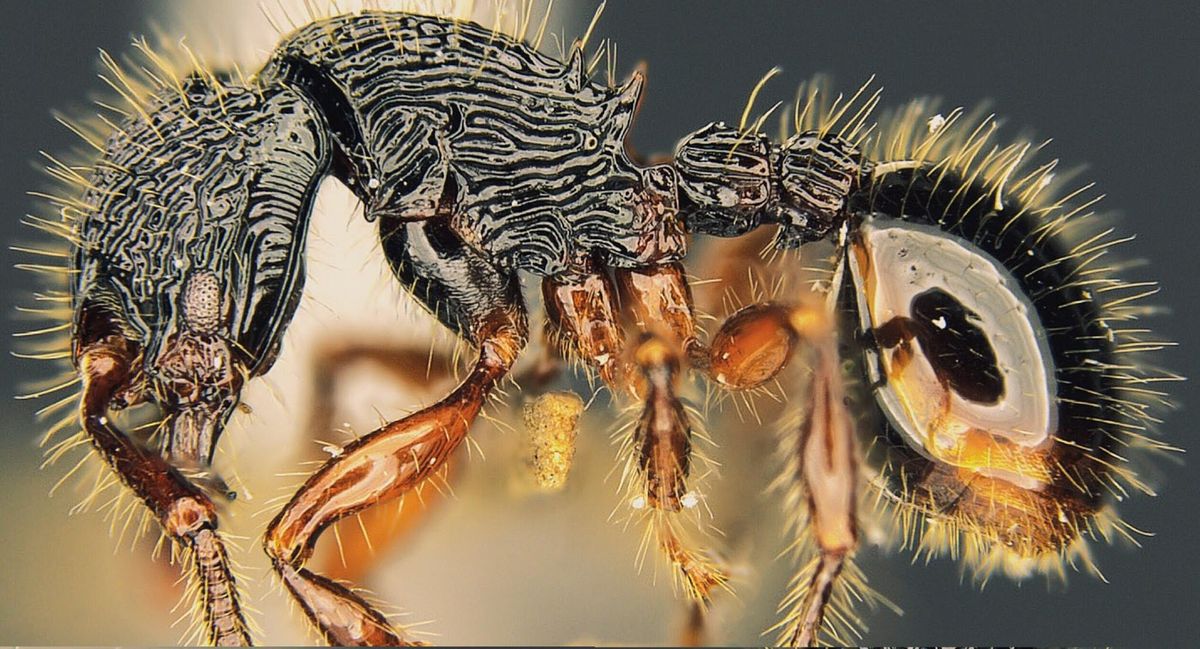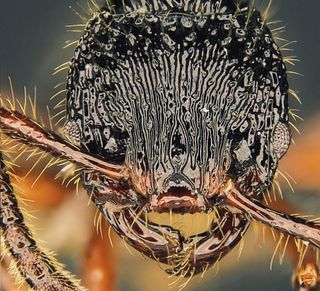'Fearsome Raisin' Ant Sports Striking Fingerprint Pattern

A new species of spiny ant with intricate, wrinkled skin has been found in the Singaporean rainforest.
Myrmecina magnificens, named for its beauty, lives in leaf litter on the forest floor and probably preys on tiny mites, said discoverer Mark Wong, an ecologist and independent researcher in Singapore. It has skin with a fingerprint-whorl pattern and delicate golden spines that point, unusually, toward the front of its body.
"Some people say it looks a little bit like a fearsome raisin," Wong told Live Science. [Cool Close-Up Photos Show Ants of the World]
Sifting the leaves
Wong found the new ant in his free time; he's been working to describe new ant species in the little-studied primary rainforests in Singapore, where logging has been limited and there has been little research on ants in decades, he said.
He found M. magnificens by collecting and sifting through a sample of leaf litter. The detritus on the forest floor is home to many species, Wong said.
"It's where you're most probably going to find something interesting," he said.
After discovering the unknown species in this way, Wong captured some additional ant workers by baiting traps with tuna and burying them 2 inches (5 centimeters) under the soil. In total, he captured and described five individuals of the new species.
Sign up for the Live Science daily newsletter now
Get the world’s most fascinating discoveries delivered straight to your inbox.
Part of the ecosystem

The new ant measures about 0.18 inches (4.5 millimeters) long. This is the first known species of Myrmecina ever discovered from the Malay Peninsula, Wong and his co-author, Benoit Guénard of the University of Hong Kong, wrote in the Journal of Hymenoptera Research on June 27. The Malay Peninsula contains the southernmost tip of Myanmar, Southern Thailand, West Malaysia and Singapore.
Tiny, urbanized Singapore might seem like a strange place to find new species, Wong said. But it's a good spot to look, because the rainforests there are relatively unaffected by human activities such as logging, he said.
M. magnificens is also the first of its genus to sport front-facing spines, Wong said. Some other members of the group have similar spines, but they all face backward. Researchers aren't sure what the fingerprint pattern is for, Wong said. It might help ants trap chemical compounds called pheromones (used for communication) near their skin, or it might help keep the ants from drying out. But so far, that's speculation, Wong said. Likewise, the spines might be used for defense, but researchers aren't sure.
Similarly, little is known about the new ant's lifestyle. Other Myrmecina species eat tiny moss mites and nest in small colonies of fewer than 100 individuals.
There have been about 15,000 species of ants described so far, with many species still undiscovered, Wong said. (He's documenting the species of Singapore up-close on his Instagram feed.) These tiny creatures are crucial for recycling nutrients back into forest soil, he said, and because of the link they occupy in the food chain. In Southeast Asia, for example, the critically endangered Sunda pangolin (Manis javanica) eats a diet heavily reliant on ants.
M. magnificens, isn't the only ant to make use of colorful hairs. The Saharan silver ant boasts silver "fur" that reflects sunlight like a mirror, keeping the desert ants cool.
Original article on Live Science.
Editor's Note: This article was updated to correct the area where the ant lives and also to clarify that it's the fingerprint pattern that scientists are puzzled about.

Stephanie Pappas is a contributing writer for Live Science, covering topics ranging from geoscience to archaeology to the human brain and behavior. She was previously a senior writer for Live Science but is now a freelancer based in Denver, Colorado, and regularly contributes to Scientific American and The Monitor, the monthly magazine of the American Psychological Association. Stephanie received a bachelor's degree in psychology from the University of South Carolina and a graduate certificate in science communication from the University of California, Santa Cruz.











